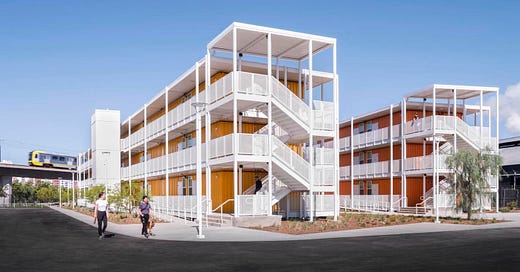AIDS Healthcare Foundation's Uses 340B Dollars to Enlarge Housing Empire
More on the creative ways the AIDS Healthcare Foundation uses the profits from 340B drug pricing arbitrage.
According to its website, “CRATE manufactures modular construction components for buildings using recycled shipping containers.”
There’s not a lot of information about Crate Modular. Estimated revenues are 22 million a year. On average, earnings before depreciation, interest, and taxes (EBITDA) in the construction materials industry are about 20 percent. So, let’s say Crate Modular’s EBITDA is around $4 million. The value of a construction materials company runs about 11 times EBITDA or $44 million. AHF took a majority stake, which we can presume cost it at least $23 million.
The investment was made by AHF Ventures, “the corporate development, business growth strategy, and investment arm “ of AHF. The AHF Vetures website notes that it “focuses on improving healthcare and affordable housing delivery models, developing and/or expanding businesses and programs, innovating new models of care and housing, and mergers and acquisitions (M&A).”
AHF Ventures was established in 2016. It is never mentioned in its IRS filings or audited financial statements. There is never a separate accounting of the return on those investments or a separate annual report. In other words, we don’t know how AHF Ventures operates even though it manages about $145 million in assets (not including the multimillion-dollar majority ownership in Crate Modular).
To complicate matters, AHF housing projects are developed and run by another subsidiary, the Healthy Housing Foundation.
Supposedly, modular construction “lowers the costs of planning, engineering, and construction. The economic benefits to the developer include lower construction costs, half-time delivery, and earlier occupancy for the tenant or owner.”
It also fits nicely into the AHF housing business model, which is to buy, operate, and sell housing that is 100 percent financed with AHF cash. Additionally, AHF does not participate in the low-income housing tax credit program. One possible reason is that tax credits are conditioned on keeping rents low for 15 years and strict limits on the amount of dedicated commercial space. AHF is always open to flipping properties or charging market rents to turn a nice profit. Indeed, as I pointed out in my last article, the housing the Healthy Housing Foundation runs on behalf of AHF is anything but healthy. (It does build nice parade floats, though.)
Indeed, in 2020, AHF/HHF/AHF Ventures paid $4.32 million to buy most of the townhomes in the Villa Tuscany townhouse development located in Fort Lauderdale, which was next to the site of AHF’s proposed low-income, 15-story high-rise. AHF suggested it bought the townhomes to win Ft. Lauderdale government city approval for the complex. AHF Michael Kahane said buying up townhomes was necessary because “AHF must try to mollify neighbors like the Villa Tuscany owners who oppose the project,”
At first, AHF claimed that staffers — not clients — would live in the housing. (Doing so would jeopardize the group’s non-profit status, making the claim bogus. Instead, AHF sold the units in 2022 for $15.2 million, Not a bad return on a $4.2 million investment. And by pure coincidence, the low-income housing was never built.
Let me restate a point I made in my last article about AHF. There is no requirement that 340B entities pass the discount on to patients, nor are they required to use the revenues generated by the program on the health care services or benefits provided by the 340B entity.
As I noted, the spread of the sale of HIV drugs is enormous. According to the New York Times, AHF purchases HIV drugs, like Genvoya, which costs “about $34,000 per patient annually. When a patient uses an AHF pharmacy, about $22,000 of that bill goes to Gilead, and $12,000 goes to AHF.” The high cost of HIV drugs provides AHF “gold mines,” allowing the organization to grow exponentially, and its “coffers have swelled,” topping nearly $2 billion in 2021.
I noted that Congress enacted the 340B program to allow organizations to extend their reach to care for more people and increase the array of health services they may require.
Instead, AHF has wasted 340B revenues on running slums, flipping condos, and construction companies. Separate AHF entities are running these activities. They should be able to operate with investment and revenue generated from other sources. Indeed, AHF’s audited statements do not break down the income and expenses, assets, and liabilities of HHF or AHF. The absence of transparency and accountability is breathtaking.
And this massive real estate operation is only one part of the AHF business model. It doesn’t include the hundreds of millions AHF has spent on political campaign donations and picketing local opponents to its housing ambitions. In my next article, we will discuss AHF’s use of 340B patients and patient-generated dollars for political purposes.





